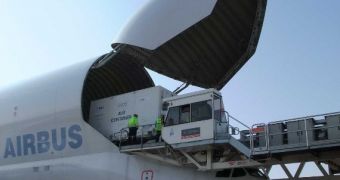Officials at the European Space Agency (ESA) announce that the organization's third automated transfer vehicle (ATV), called Edoardo Amaldi, is beginning to take shape in Bremen, Germany. The resupply capsule is not scheduled to take off earlier than February 2012.
The first vehicle in the ATV series, Jules Verne, launched to the International Space Station (ISS) on March 9, 2008, and reentered Earth's atmosphere on September 29, the same year.
Johannes Kepler is the second spacecraft of the series. It is currently scheduled to take off to the ISS on February 15, 2011, carrying food, water, propellant for the station's thrusters, experiments, space parts and personal items for the six astronauts of Expedition 26.
Edoardo Amaldi is to be the third ATV, and its turn will not come until next year. ESA has designated it as ATV-3, and some of its main components have already arrived at an EADS Astrium facility, in Bremen, Germany.
The company is the main contractor ESA selected for this program. According to the official scheduled, maneuvers to assemble the existing components of Eduardo Amaldi will begin at the end of January.
One of the largest pieces in the ATV-3 has already arrived at the integration facility. The Integrated Cargo Carrier (ICC) is a voluminous container totaling about 60 percent of the spacecraft's mass.
Its job is to seal and carry up to 7.5 tonnes of material, including all the liquid and dry cargo that Eduardo Amaldi will take to low-Earth orbit (LEO). The ICC was built by Italy-based company Thales Alenia Space.
It arrived at EADS just before Christmas, carried by a voluminous Beluga aircraft from the Turin airport (as shown in the attached image). The other components of the space capsule will be built and assembled around the ICC.
Another component that has been finalized is the Equipped Propulsion Bay, a container that includes the engines and propellant tanks. The Equipped Avionics Bay – containing computers and flight control systems – has also been delivered from France, and is ready for integration.
The Bremen facility needs to finish the assembly of the ATV by no later than September 2011. This is when it is due to be transported to the Kourou Spaceport, the launch facility ESA operates in French Guyana.
"”he main challenges of Edoardo Amaldi will be not only to perform its very complex mission as successfully as its predecessors, but also to prepare it within a much shorter interval since the previous one,” explains Massimo Cislaghi.
“This implies, for instance, that any technical information from the Johannes Kepler mission will become available only when the Edoardo Amaldi preparations are already at a very advanced stage,” adds the official, who is the ESA ATV-3 mission manager.

 14 DAY TRIAL //
14 DAY TRIAL //